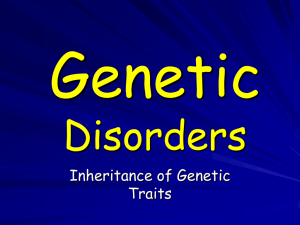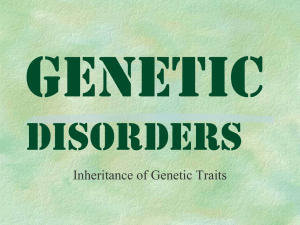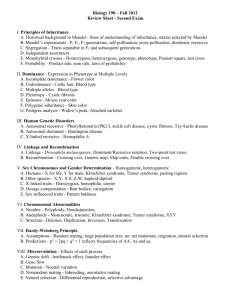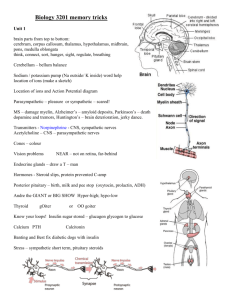Genetic Disorders
advertisement
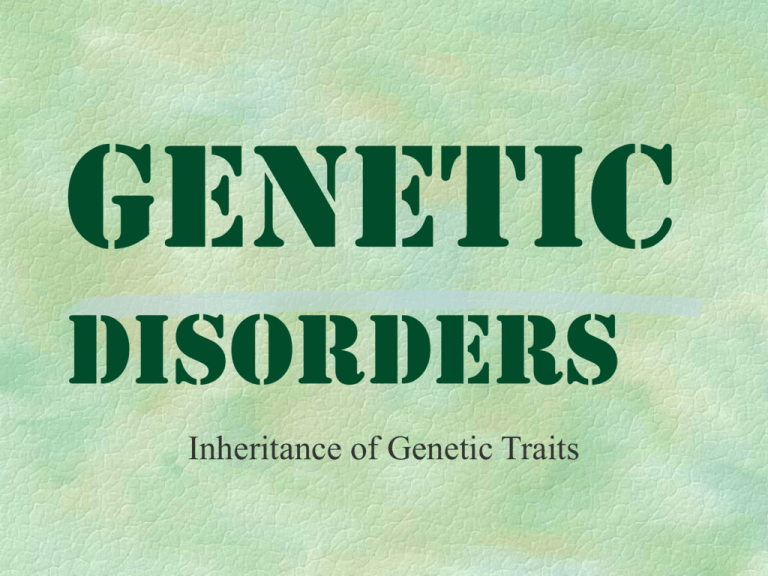
Genetic Disorders Inheritance of Genetic Traits Brief History First there was Gregor Mendel, a monk who studied inherited characteristics. This was followed by Francis crick and James Watson who unraveled the DNA molecule. This has led us to understanding the human genome sequence Gregor Mendel 1866 Gregor Mendel published the results of his investigations of the inheritance of "factors" in pea plants. Rosalind Franklin 1950's. Maurice Wilkins (1916- ), Rosalind Franklin (19201957), Francis H. C. Crick (1916- ) of Britain and James D. Watson (1928- ) of the U.S. Discover chemical structure of DNA, starting a new branch of science--molecular biology. . Watson and Crick Watson and Crick made a model of the DNA molecule and proved that genes determine heredity Arthur Kornberg 1957 Arthur Kornberg (1918- ) of the U.S. produced DNA in a test tube. Genetic code 1966 The Genetic code was discovered; scientists are now able to predict characteristics by studying DNA. This leads to genetic engineering, genetic counseling. Barbara McClintock 1983 Barbara McClintock (1902-1992) of the U.S. was awarded the Nobel Prize for her discovery that genes are able to change position on chromosomes. DNA Fingerprinting The late 1980's. An international team of scientists began the project to map the human genome. The first crime conviction based on DNA fingerprinting, in Portland Oregon. Gene Therapy 1990. Gene therapy was used on patients for the first time. Dr. Kary Mullis 1993 Dr. Kary Mullis discovered the PCR procedure, for which he was awarded the Nobel prize. DNA Testing 1995. DNA testing in forensics cases gains fame in the O.J. Simpson trial. Cloning Begins 1997. Dolly the sheep - the first adult animal clone. Human Genome Project Imagine a world in which we will be able to treat diseases by altering our very genes‚ giving us new ones if ours are nonfunctional, changing bad genes for good ones. For the first time in our existence, we are closer to understanding just what we are. We now have the tools to make the whole world better through science ‚ the science of the human genome. Genetic Disorders Mutations Gene mutations can be either inherited from a parent or acquired. A hereditary mutation is a mistake that is present in the DNA of virtually all body cells. Hereditary mutations are also called germ line mutations because the gene change exists in the reproductive cells and can be passed from generation to generation, from parent to newborn. Moreover, the mutation is copied every time body cells divide Mutations occur all the time in every cell in the body. Each cell, however, has the remarkable ability to recognize mistakes and fix them before it passes them along to its descendants. But a cell's DNA repair mechanisms can fail, or be overwhelmed, or become less efficient with age. Over time, mistakes can accumulate. Down’s Syndrome Caused by nondisjunction of the 21st chromosome. This means that the individual has a trisomy (3 – 2lst chromosomes). Down’s Syndrome or Trisomy 21 Symptoms of Down Syndrome Upward slant to eyes. Small ears that fold over at the top. Small, flattened nose. Small mouth, making tongue appear large. Short neck. Small hands with short fingers. Symptoms of Down Syndrome Low muscle tone. Single deep crease across center of palm. Looseness of joints. Small skin folds at the inner corners of the eyes. Excessive space between first and second toe. In addition, down syndrome always involves some degree of mental retardation, from mild to severe. In most cases, the mental retardation is mild to moderate. Kleinfelter’s syndrome (or Klinefleter’s) Disorder occurring due to nondisjunction of the X chromosome. The Sperm containing both X and Y combines with an egg containing the X, results in a male child. The egg may contribute the extra X chromosome. XXY Males with some development of breast tissue normally seen in females. Little body hair is present, and such person are typically tall, have small testes. Infertility results from absent sperm. Evidence of mental retardation may or may not be present. Klinefleter’s Turner’s Turner syndrome is associated with underdeveloped ovaries, short stature, webbed, and is only in women. Bull neck, and broad chest. Individuals are sterile, and lack expected secondary sexual characteristics. Mental retardation typically not evident. Chromosomal or monogenic? Turner’s Syndrome Sickle Cell Anemia An inherited, chronic disease in which the red blood cells, normally disc-shaped, become crescent shaped. As a result, they function abnormally and cause small blood clots. These clots give rise to recurrent painful episodes called "sickle cell pain crises". Sickle Cell Sickle cell disease is most commonly found in African American populations. This disease was discovered over 80 years ago, but has not been given the attention it deserves. Cystic Fibrosis (CF) Monogenic Cause: deletion of only 3 bases on chromosome 7 Fluid in lungs, potential respiratory failure Common among Caucasians…1 in 20 are carriers Therefore is it dominant or recessive? Tay-Sachs disease Monogenic, autosomal recessive Central nervous system degrades, ultimately causing death. Most common among people of Jewish, eastern Europe descent. Muscular Dystrophy What Is Muscular Dystrophy? Muscular dystrophy is a disease in which the muscles of the body get weaker and weaker and slowly stop working because of a lack of a certain protein (see the relationship to genetics?) Can be passed on by one or both parents, depending on the form of MD (therefore is autosomal dominant and recessive) Hemophilia, the royal disease Hemophilia is the oldest known hereditary bleeding disorder. Caused by a recessive gene on the X chromosome. There are about 20,000 hemophilia patients in the United States. One can bleed to death with small cuts. The severity of hemophilia is related to the amount of the clotting factor in the blood. About 70% of hemophilia patients have less than one percent of the normal amount and, thus, have severe hemophilia. X-linked Inheritance pedigree chart Huntington’s Disease Huntington's disease (HD) is an inherited, degenerative brain disorder which results in an eventual loss of both mental and physical control. The disease is also known as Huntington's chorea. Chorea means "dance-like movements" and refers to the uncontrolled motions often associated with the disease. Huntington’s Looking back at the pedigree chart is Huntington’s dominant or recessive? Scientists have discovered that the abnormal protein produced by the Huntington's disease gene, which contains an elongated stretch of amino acids called glutamines, binds more tightly to HAP-1 than the normal protein does. Phenylketonuria or PKU People with PKU cannot consume any product that contains aspartame. PKU is a metabolic disorder that results when the PKU gene is inherited from both parents (recessive or dominant? Monogenic or chromosomal?) Caused by a deficiency of an enzyme which is necessary for proper metabolism of an amino acid called phenylalanine. PKU Phenylalanine is an essential amino acid and is found in nearly all foods which contain protein, dairy products, nuts, beans, tofu… etc. A low protein diet must be followed. Brain damage can result if the diet is not followed causing mental retardation…and mousy body odor (phenylacetic acid is in sweat). PKU Phenylalanine. Free diet ALS (Amyotrophic Lateral Sclerosis, or Lou Gehrig’s disease) the disease strikes people between the ages of 40 and 70, and as many as 30,000 Americans have the disease at any given time This monogenic mutation is believed to make a defective protein that is toxic to motor nerve cells. A common first symptom is a painless weakness in a hand, foot, arm or leg, other early symptoms include speech swallowing or walking difficulty Adenoleukodystrophy ALD) is a rare, inherited metabolic disorder that afflicts the young boy Lorenzo Odone, whose story is told in the 1993 film 'Lorenzo's oil'. In this disease the fatty covering (myelin sheath) on nerve fibers in the brain is lost, and the adrenal gland degenerates, leading to progressive neurological disability and death. Lorenzo’s Oil Their invention, Lorenzo's Oil, has been adopted as the therapy of choice for ALD by major neurological institutes the world over. Lorenzo Odone The oil came too late to stop his son from developing the symptoms must be hard to bear. Lorenzo lost most of his bodily functions and has been bedridden for 18 years. Diabetes Disease in which the body does not produce or properly use insulin. Insulin is a hormone that is needed to convert sugar, starches, and other food into energy needed for daily life. Genetic mutation can lead to Type 1 diabetes, but no one sure if relative to a specific gene Diabetes Type 1 reveals itself in childhood, Type 2 can be made worse from excessive lifestyle Warning signs Extreme thirst Blurry vision from time to time Frequent urination Unusual fatigue or drowsiness Unexplained weight loss Diabetes is the leading cause of kidney failure, blindness, and amputation in adults, and can also lead to heart disease. Color Blindness Cause: x-linked recessive 1/10 males have, 1/100 females have. Why the difference? Individuals are unable to distinguish shades of red-green. Are you color blind? Albinism Patients are unable to produce skin or eye pigments, and thus are light-sensitive Autosomal recessive Therefore, is it monogenic or chromosomal? Achondroplasia (a.k.a. dwarfism) Monogenic, autosomal Carriers express genes, therefore, is it dominant or recessive? There is also a disease called gigantism (Andre the Giant) The very tragic disease… hairy ears Y-linked trait, which are rare symptoms…hairy ears Only 1 cure known….
